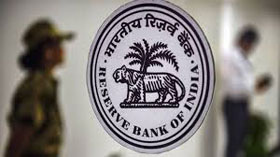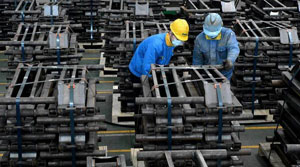January 2021 Economic Affairs
Sakshi Education
- In Google and FB’s Australian tussle, issues of concern for India as well
 Due to slugfest between the Australian government and global tech platforms over the sharing of royalties with news publishers, Google has threatened to remove its search engine from the country, and Facebook could block Australian users from posting or sharing news links if proposed norms on royalty payments are rolled out Policymakers in India have so far focussed on the dominance of intermediaries such as Google and Facebook, which are positioned in a way that service providers cannot reach customers except through these platforms.
Due to slugfest between the Australian government and global tech platforms over the sharing of royalties with news publishers, Google has threatened to remove its search engine from the country, and Facebook could block Australian users from posting or sharing news links if proposed norms on royalty payments are rolled out Policymakers in India have so far focussed on the dominance of intermediaries such as Google and Facebook, which are positioned in a way that service providers cannot reach customers except through these platforms.
The showdown is being closely watched by regulators and digital platforms across geographies.
The issues being thrashed out in Australia and elsewhere could have broader implications for the regulation of the digital economy in India in the longer term.
Media industry is already benefiting from traffic being routed to them by each of the digital platforms, and that the new rules proposed by the Australian authorities would expose them to “unmanageable levels of financial and operational risk.”
- ‘Pandemic pushes States’ borrowings up by 82.5%’
States’ borrowings during April-December 2020 were 82.5% higher compared with the corresponding period of the previous year, on account of the pandemic. Till December 11, 2020, the States netted Rs.4.6 lakh crore through market borrowings.
The figure included Rs.36,000 crore borrowed by the Centre and passed on to the States to meet the shortfall in revenue arising on account of the Goods and Services Tax (GST) implementation.
The current financial year’s figure of borrowings pertained to net borrowings, which excluded repayments, and this was compared with similar borrowings made in the previous year.
A perusal of data available on revenue receipts of 21 states reveals that while the states raised only 37% of the full-year target during April-October 2020, they generated 52% of their annual revenue in the corresponding period of 2019.
- RBI moots scale-based tighter regulatory framework for NBFCs
The Reserve Bank of India (RBI) has suggested a tougher regulatory framework for the non-banking finance companies’ (NBFC) sector to prevent recurrence of any systemic risk to the country’s financial system.
The banking regulator released a discussion paper on the revised regulatory framework which is formulated on a scale-based approach.
It will be based on a four-layered structure — the base layer (NBFC-BL), middle layer (NBFC-ML), upper layer (NBFC-UL) and the top layer.
If the framework is visualised as a pyramid, the bottom of the pyramid, where least regulatory intervention is warranted, can consist of NBFCs currently classified as non-systemically important NBFCs (NBFC-ND), NBFCP2P lending platforms, NBFCAA, NOFHC and Type I NBFCs.
Moving up, the next layer may comprise NBFCs currently classified as systemically important NBFCs (NBFC-ND-SI), deposit-taking NBFCs (NBFC-D), HFCs, IFCs, IDFs, SPDs and CICs.
The regulatory regime for this layer shall be stricter compared to the base layer. Adverse regulatory arbitrage vis-à-vis banks can be addressed for NBFCs falling in this layer in order to reduce systemic risk spill-overs, where required.
The next layer may consist of NBFCs identified as ‘systemically significant’. This layer will be populated by NBFCs having a large potential of systemic spill-over of risks and the ability to impact financial stability.
The extant regulatory framework for NBFC-NDs will now be applicable to base layer NBFCs, while the extant regulatory framework applicable for NBFC-NDSI will be applicable to middle layer NBFCs. NBFCs residing in the upper layer will constitute a new category.
The revisions applicable to lower layers of NBFCs will automatically be applicable to NBFCs in the higher layers, unless there is a conflict or otherwise stated.
The current threshold for systemic importance, which is Rs.500 crore now, is proposed to be revised to Rs.1,000 crore.
As per the proposals, the extant NPA classification norm of 180 days will be reduced to 90 days. The regulatory framework for NBFCs needs to be reoriented to keep pace with changing realities in the financial sector.
- India sees sharpest rise in FDI inflows among key nations
An ‘investment trends monitor’ namely World Economic Situation and Prospects has been issued by the United Nations Conference on Trade and Development (UNCTAD).
According to the United Nations, Foreign Direct Investment (FDI) into India rose by 13 per cent in 2020, boosted by interest in the digital sector.
Fund flows “declined most strongly” in major economies like the UK, the USA and Russia due to the Covid-19 pandemic, India and China “bucked the trend”.
Global foreign direct investment (FDI) collapsed in 2020 by 42 per cent to an estimated $859 billion from $1.5 trillion in 2019.
Such a low level was last seen in the 1990s and is more than 30 per cent below the investment trough that followed the 2008-2009 global financial crisis.
The decline in FDI in flows was concentrated in developed countries, where fund flows decreased by 69 per cent to an estimated $229 billion. However, FDI in India rose 13 percent, boosted by investments in the digital sector.
The government policies and reforms have made India a preferred destination for foreign direct investments and the inflows grew at the fastest rate among top economies.
India’s economy is estimated to contract by 9.6 per cent in 2020, as lockdowns and other efforts to control Covid-19 slashed domestic consumption without halting the spread of the disease, and the growth is expected to recover and grow at 7.3 percentin2021.
In 2020, the world economy shrank by 4.3 per cent, over two and half times more than during the global financial crisis of 2009.
- China overtakes US as world’s leading destination for foreign direct investment
The latest data from the United Nations Conference on Trade and Development (UNCTAD) highlights that by 2020, China has surpassed the United States to become the world's largest foreign direct investment destination.
The eastward shift of destinations is the result of the Covid-19 pandemic, and the United States is still recovering from it. By 2020, new investment by overseas companies in the United States has fallen by 49%.
China has attracted new investment in 2020, while the United States has maintained a high position in terms of total foreign investment.
The increase in inventories shows that the United States has been the most attractive region for foreign companies for decades.
Foreign investment in the United States began to pick up in 2016. By 2016, the investment amount was 472 billion US dollars, while the total foreign investment in China was 134 billion US dollars. However, since 2017, investment in China has continued to grow, while investment in the United States has continued to decline.
Investments made by entities headquartered in another country in the form of controlling the ownership of companies in one country are called foreign direct investment.
Therefore, in terms of direct control, it is different from foreign portfolio investment. The source of investment does not affect the definition of foreign direct investment.
It is a group of assets such as stocks, bonds and cash equivalents. Such investments are directly held by investors or managed by financial professionals.
Economically speaking, this kind of investment means importing funds into a country where foreigners deposit money in a country’s bank or purchase it in the country’s stock and bond markets.
- RBI moots scale-based tighter regulatory framework for NBFCs
The Reserve Bank of India recommends that the non-banking financial company (NBFC) sector adopt a stricter regulatory framework to prevent any systemic risks from recurring to the country’s financial system.
The Reserve Bank of India released a discussion paper on the revised regulatory framework, which was developed on a scale-based approach and solicited comments within one month.
The regulatory and supervisory framework of NBFC will be based on a four-layer structure-base layer (NBFC-BL), middle layer (NBFC-ML), upper layer (NBFC-UL) and top layer.
If the framework is visualized as a pyramid, the bottom of the pyramid (which requires minimal regulatory intervention) can consist of NBFCs currently classified as non-systemically important NBFCs (NBFC-ND), NBFCP2P lending platforms, NBFCAA, NOFHC and Type I NBFCs.
The next level can include NBFCs currently classified as systemically important NBFCs (NBFC-ND-SI), deposit-accepting NBFCs (NBFC-D), HFCs, IFCs, IDFs, SPDs, and CICs.
The existing NBFC-ND regulatory framework will now apply to the base layer NBFCs.
The existing regulatory framework applicable to NBFC-NDSI will apply to the middle-tier NBFCs.
NBFCs residing in the upper level will constitute a new category.
The current threshold for systemic importance is now 5 billion rupees, and it is proposed to be revised to ?1,000 crore.
According to the proposal, the existing 180-day NPA classification standard will be reduced to 90 days.
- India’s GDP to contract 8% in FY21: FICCI Survey
According to the latest round of FICCI’s Economic Outlook Survey, India’s GDP is expected to contract by 8% in 2020-21.
The annual median growth forecast by the industry body is based on responses from leading economists representing industry, banking and financial services sectors.
The median growth forecast for agriculture and allied activities has been pegged at 3.5% for 2020-21.
Agriculture sector has exhibited significant resilience in the face of the pandemic. Higher rabi acreage, good monsoons, higher reservoir levels and strong growth in tractor sales indicate continued buoyancy in the sector.
Industry and services sector, which were most severely hit due to the pandemic induced economic fallout, are expected to contract by 10% and 9.2% respectively during 2020-21. The industrial recovery is gaining traction, but the growth is still not broad based.
The consumption activity did spur during the festive season as a result of pent-up demand built during the lockdown but sustaining it is important going ahead.
Some of the contact intensive service sectors like tourism, hospitality, entertainment, education, and health sector are yet to see normalcy.
The quarterly median forecasts indicate GDP growth to contract by 1.3% in the third quarter of 2020-21. The growth is expected to be in the positive terrain by the fourth quarter with a projection of 0.5% growth.
- Overseas investment by Indian companies dips 42% to $1.45 billion in December: RBI
According to Reserve Bank data, overseas investment by domestic firms fell by over 42% to $1.45 billion in December 2020
In 2020, companies in India had invested $2.51 billion in their foreign firms (joint ventures / wholly owned units).
In November 2020, the total outward foreign direct investment (OFDI) was of $1.06 billion, down by 27% from a month earlier.
Of the total FDI investment by the Indian companies during the month under review, $775.41 million was in the form of equity infusion and $382.91 million was in the form of loan.
Investment of $287.63 million was in the form of issuance of guarantee.
- Cabinet clears policy on PSU privatisation ahead of Union Budget
The Union Cabinet has cleared the policy of privatization of public sector enterprises. Detailed information about this policy will be announced in the forthcoming alliance budget to be submitted on February 1, 2021.
The policy will provide a roadmap for the existence of government-owned entities in strategic and non-strategic areas. This policy is part of the Aatmanirbhar Bharat package announced by the Minister of Finance in May 2020.
This is a coherent policy announcing that all sectors will be open for private sector participation.
The government also announced that it will limit the number of PSUs in strategic sectors to one to four. The government hopes to privatize the remaining companies, merge or incorporate them into holding companies. After this policy takes effect, the government will completely withdraw from companies in non-strategic sectors.
The timing of privatization of companies in non-strategic sectors will depend on specific circumstances.
The Ministry of Investment and Public Asset Management classified 18 departments as strategic departments. It includes-fertilizer, telecommunications, power, banking, defense and insurance. These industries have been classified as mining and exploration, manufacturing and processing and services.
In India, state-owned enterprises are called public sector enterprises (PSU) or public sector enterprises. The PSU is owned by the Union government or one of the state or regional governments. It can also be partially owned by two. Most of the company’s shares in the government-owned PSU.
There are two types of PSU: Central Public Sector Enterprise (CPSU, CPSE) or State Public Enterprise (SLPE). PSU is managed by the Ministry of Heavy Industry and Public Enterprise. By 1951, there were only five companies in the public sector. As time passed, the number increased. As of March 2019, this number has increased to 348.
- Trade with China shrank in 2020, deficit at five-year low
 According to new figures from China’s General Administration of Customs (GAC), India’s trade with China declined in 2020 to the lowest level since 2017.
According to new figures from China’s General Administration of Customs (GAC), India’s trade with China declined in 2020 to the lowest level since 2017.
Trade deficit narrowed to a five-year low as India imported far fewer goods from China.
Bilateral trade decreased 5.6% to $87.6 billion, India’s imports from China shrank by 10.8% to $66.7 billion, marking the lowest level of inbound shipments since 2016.
India’s exports to China, however, jumped 16%, crossing the $20 billion-mark for the first time to a record high of $20.86 billion.
The trade deficit, a source of friction in bilateral ties, shrank to $45.8 billion, the lowest level since 2015. India’s biggest import in 2019 was electrical machinery and equipment, and fertilizers, while India’s top exports that year were iron ore, organic chemicals, cotton and unfinished diamonds.
Demand for iron ore increased in China, as new infrastructure projects aimed at reviving growth after the COVID-19 slump lifted consumption of steel. Total iron ore imports in Asia’s largest economy rose 9.5% in 2020.
The drop in India’s imports from China largely mirrored a decline in overall inbound shipments last year as domestic demand slumped in the wake of the pandemic.
That makes it difficult to determine whether 2020 is an exception or marks a turn away from the recent pattern of India’s trade with China, especially since there is, as yet, no evidence to suggest India has replaced its import dependence on China by either sourcing those goods elsewhere or manufacturing them at home.
China was “the world’s only major economy to have registered positive growth in foreign trade in goods, with China’s foreign trade and exports in the first 10 months of the year accounting for a record 12.8% and 14.2% share of the global totals, respectively.
China posted sharp increases with most of its major trading partners. Exports to the ASEAN bloc, China’s largest trading partner last year with bilateral trade rose 6.7%, while exports to the EU, China’s second-largest trading partner, also rose 6.7% as total trade reached $649 billion. Despite the trade war with the U.S. and the pandemic, two-way trade was up 8.3% to $586 billion, with China’s exports rising 7.9% to reach a record $451 billion.
- Indian economy ‘weak,’ credit growth bottoming out: BofA
According to the American brokerage BofA Securities, the Indian economy continues to be ‘weak,’ pointing to activity indicators tracked by it.
It has been noted that on the positive side, credit demand is decreasing and the real lending rates, adjusted for wholesale price inflation, are falling. It can also be noted that there has been a slew of reports lately about a stronger recovery being underway after the jolt caused by the pandemic. The government expects the GDP to contract 7.7% in financial year 2021 because of the reverses.
The continued drop in our BofA India Activity Indicator reinforces our view that the economy still remains weak. The indicator fell by 0.6% in November on top of the 0.8% decline in October, and 4.6% drop in the September quarter.
This supports our call of GVA (Gross Value Added) contractions of 1% in the December quarter and 6.7% in FY21.
The credit growth for FY22 will come at 12%. It can be noted that credit growth had been declining for the last few years, in sync with a dip in the overall economic growth which has been on a downward spiral since demonetization in late 2016 as borrowers went slow on expansion.
The real lending rates adjusted for WPI will be one of the prime reasons for the faster credit growth estimate in financial year 2022.
- To spur growth & jobs, booster for construction and low-cost housing
Budget 2021-22 is expected to give a special focus to construction development and affordable housing as increased activity in these areas provide a higher boost to overall demand in the economy because of their forward and backward linkages.
The government plans further liberalisation of foreign direct investment (FDI) regulations for the construction development sector while a higher allocation is expected towards a credit-linked subsidy scheme for affordable housing.
One factor behind the exodus of migrants from cities during the pandemic was their lack of access to safe, affordable housing in urban clusters.
Significantly, as part of the pandemic slowdown stimulus, several state governments provided various concessions in stamp duty and other charges to kickstart transaction activity in the construction and real estate sector. The Centre, too, set up a fund to provide last-mile funding to stressed housing projects across the country.
Revival of construction development sector is also seen as crucial for employment creation. While 100 per cent FDI is already permitted in construction development sector, certain legal structures such as LLP are not allowed to receive foreign investment in this sector.
There has also been demand to raise allocation under Pradhan Mantri Awas Yojana (PMAY) from the Rs 27,500 crore allocated in the Union Budget 2020-21 to ensure every Indian has a home in the near future.
To provide relief to stressed home buyers, funds could also be set aside for the National Building Construction Corporation to complete stalled projects which have been stuck due to fund shortage.
This would boost consumer sentiment and revive up the demand cycle. There could be a provision to recover the costs involved once the project is completed.
- India's budget seen raising import duties by 5%-10% on dozens of items
India is considering raising import duties by 5%-10% on more than 50 items including smartphones, electronic components and appliances in the upcoming budget.
The move to increase import duties is part of Prime Minister’s self-reliant India campaign that aims to promote and support domestic manufacturing.
Government was seeking to target additional revenue of about 200 billion to 210 billion, as it looks to shore up revenue amid the COVID-19 pandemic-driven slowdown that has stung the economy.
The list of items likely to attract steeper duties is set to include appliances such as refrigerators and air conditioners too.
Last year, India raised duties on a range of products such as footwear, furniture, toys, electrical and electronics items by up to 20%.
- UN Released International Migration 2020 Report
The United Nations (UN) released the International Migration 2020 Highlights report. According to the report, Indian diaspora is the largest in the world. As of 2020, more than 18 million people from India are living outside India.
Other diaspora countries are Mexico, China, Russia, and Syria.
According to this report, Indian diasporas are distributed in many major countries, such as the UAE (3.5 million), Saudi Arabia (2.5 million) and the United States (2.7 million).
Some other countries that receive high numbers of immigrants from India are Oman, Australia, Kuwait, Canada, Qatar, Pakistan and the United Kingdom.
Between 2000 and 2020, the size of immigrant populations in all countries is increasing. During his tenure, India received the largest gain of nearly 10 million. India is followed closely by Syria, Venezuela, China and the Philippines.
The places where the immigrant population increased during this period were Ukraine, Pakistan, Tanzania, Armenia, India, and Ukraine. Immigration to India is for labor and family reasons.
The United States is the largest destination country for international immigrants. As of 2020, there are more than 51 million immigrants in the United States. This is equivalent to 18% of the world's total immigrant population.
The United States is close behind. Germany has hosted the second largest immigrants in the world, with an immigrant population of more than 16 million. Germany is closely followed by Saudi Arabia, Russia and the United Kingdom.
The number of international immigrants increased by 281 million. It was 221 million in 2010 and 173 million in 2000.
Currently, the total number of international immigrants accounts for about 3.6% of the world's population.
In terms of regional migration corridors, Central Asia and South Asia to North Africa and West Asia have seen the most growth. In these corridors, the immigrant population has almost tripled between 2000 and 2020.
- Finance Ministry releases weekly instalment of Rs 6,000 cr to states to meet GST compensation shortfall
The 12th instalment of Rs. 6,000 crore was issued as back-to-back loans to the states to make up for the shortfall in GST compensation.
The Ministry of Finance, Department of Expenditure released the 12th weekly instalment of Rs. 6,000 crore was allocated to the states to make up for the shortfall in compensation for GST.
The funds have been provided to 23 States and 3 UTs of GST council members.
Due to the implementation of GST, the remaining 5 states (Arunachal Pradesh, Manipur, Mizoram, Nagaland and Sikkim) have no income gap.
The Indian government has set up a special borrowing window in October 2020 to cover the estimated income gap of Rs.1.10 Lakh crore due to the implementation of GST.
The borrowings are being done through this window by the Government of India for the benefit of the States and UTs. Since October 2020, 12 rounds of borrowings have been completed.
- KIIFB borrowings bypass limits for State: CAG
The Comptroller and Auditor General (CAG) reported that the off-budget borrowings for critical infra projects by the Kerala Infrastructure Investment Fund Board (KIIFB) have bypassed the limits set on government borrowings under Article 293 of the Constitution as these borrowings did not have legislative approval.
Entry 37 of the List 1 of the Seventh schedule of the Constitution gives powers of raising foreign loans only to the Centre.
KIIFB borrowings are in violation of the Constitution and encroachment on the powers of the Centre.
KIIFB borrowings have not been disclosed in the Budget documents or in the accounts, which questions transparency, and of inter-generational equity of the borrowings.
It raised funds by issuance of bonds which were to be repaid from the petroleum cess and motor vehicle tax.
State was not given any opportunity to offer its comments, observations or explanation before publishing of the report by the CAG.
Funds from KIIFB are being used to build public infrastructures and such a move by CAG could hurt the interests of the State.
KIIFB Bonds were raised with the approval of RBI then how such borrowings can be unconstitutional.
- Cost of green bonds issuance high in India
A study by Reserve Bank of India (RBI) noted that the cost of issuing green bonds has generally remained higher than other bonds in India, largely due to asymmetric information.
The average coupon rate for green bonds issued since 2015 with maturities between 5 to 10 years have generally remained higher than the corporate and government bonds with similar tenure.
For the US dollar-denominated green bonds with tenure of more than or equal to 10 years, the coupon rate was, however lower than the corporate bonds.
It may be mentioned that most of the green bonds in India are issued by the public sector units 17 or corporates with better financial health.
It is evident from the fact that the private sector issuers of green bonds, on average, reported lower debt-to-assets ratio compared to the non-issuers of green bond.
Green bonds constituted only 0.7percen to fall the bonds issued in India since 2018, and bank lending to the non-conventional energy constituted about 7.9 percent of outstanding bank credit to the power sector, as of March 2020.
High borrowing cost has been perhaps the most important challenge and analysis indicates that it could be due to the asymmetric information
Therefore, developing a better information management system in India may help in reducing maturity mismatches, borrowing costs and lead to efficient resource allocation in this segment.
- Looking for lithium toehold, India finds a small deposit in Karnataka
 The Atomic Minerals Directorate for Exploration and Research (AMD), an arm of the Department of Atomic Energy, has shown the presence of 1,600 tonnes of lithium resources in the igneous rocks of the Marlagalla-Allapatna region of Karnataka’s Mandya district.
The Atomic Minerals Directorate for Exploration and Research (AMD), an arm of the Department of Atomic Energy, has shown the presence of 1,600 tonnes of lithium resources in the igneous rocks of the Marlagalla-Allapatna region of Karnataka’s Mandya district.
The find in Mandya is extremely small in quantitative terms, but it is an initial success in the attempt to domestically mine the silver-white metal by way of hard-rock extraction of the ore.
India has initiated a concerted domestic exploration push for the alkali metal, a vital ingredient of the lithium-ion rechargeable batteries that power electric vehicles (EVs), laptops and mobile phones.
AMD is carrying out surface and sub-surface exploration for lithium in potential geological domains of the country. India currently imports all its lithium needs.
The domestic exploration push, which also includes exploratory work to extract lithium from the brine pools of Rajasthan and Gujarat and the mica belts of Odisha and Chhattisgarh, comes at a time when India has stepped up its economic offensive against China, a major source of lithium-ion energy storage products being imported ]into the country.
The Marlagalla-Allapatna area, along the Nagamangala Schist Belt, which exposes mineralized complex pegmatites (igneous rocks), is seen as among the most promising geological domains for potential exploration for lithium and other rare metals.
There are, however, two caveats. First, the new find is categorized as “inferred”, one of the three categories into which mineral resources are subdivided, in order of increasing geological confidence.
The ‘inferred’ mineral resource is the part of a resource for which quantity, grade and mineral content are estimated only with a low level of confidence based on information gathered from locations such as outcrops, trenches, pits, workings, and drill holes that may be of limited or uncertain quality, and also of lower reliability.
Second, the lithium find is comparatively small, considering the size of the proven reserves in Bolivia (21 million tonnes), Argentina (17 million tonnes), Australia (6.3 million tonnes), and China (4.5 million tonnes).
- Government looks at ‘expenditure’ budget to aid higher growth
The Union Finance Ministry is of the view that higher spending at the stage of uptick in the economy will give a bigger push to growth. This growth is better than what most economists estimated post easing of lockdown restrictions.
In a pandemic year, the government restricted additional spending to less than 1.5 percent of the GDP but it will expand its spending in financial year 2021-22.
It will be more an ‘expenditure Budget’ than a revenue Budget; after consultations with various stakeholders.
The areas where the ministry of Finance is keen to increase spending are healthcare and construction-related activities, be it infrastructure or housing.
Public spending in these activities have a huge trickle down effect, and benefit many industries from cement to steel besides creating durable jobs.
High spending will mean high growth, and this itself will be an antidote to bring deficit down.
With the GDP expected to post a negative growth of 7.7 percent in 2020-21, the government expects a strong rebound next financial year. But even a 14 percent in 2021-22 (over 2020-21), would mean a growth rate of not more than 5.5 percent over 2019-20.
While the combined debt of the Centre and states as a percentage of GDP stood at 72 percent last year, it is expected to touch 85 percent given the shrinking of the GDP this year, and higher government borrowings.
It is in this backdrop that the Finance Ministry may announce making debt-GDP ratio as the primary target for fiscal policy, and provide a new glide path for reducing debt levels.
The Revised Estimate for fiscal deficit for the current financial year may be around 6.5 percent of GDP.
In making projections for next year, the government may budget only normal increases in departmental and ministerial allocations given that capacities to spend cannot improve suddenly
Towards this end, the Finance Ministry is also considering a review of the Fiscal Responsibility and Budget Management Act in line with the recommendations of the NK Singh panel, which suggested that the debt-GDP ratio (as opposed to fiscal deficit) be taken as the primary target for fiscal policy.
Under the amended FRBM Act, the government was expected to reduce its fiscal deficit to 3 percent of GDP in 2020-21.
But while presenting the Budget, Finance Ministry had invoked the escape clause for having deviated from the target for 2019-20 and 2020-21 to the extent of 0.5 percent of GDP; the Budget Estimate of fiscal deficit for 2020-21 was 3.5 percent of GDP.
- Q3 private investment in manufacturing jumps 102%
A continued rise in private investments in the third quarter (Q3) of 2020-21, led by a 102% surge in manufacturing investments, helped India register a healthy 10.3% increase in fresh project spending in Q3 over the previous quarter.
The Q3 project investment numbers suggest a reversal from recent years’ trend of government capital expenditure propping up the economy while the private sector remained reluctant to invest due to flat consumer demand and weak balance sheets.
However, new capital expenditure proposals from the government collapsed between October and December 2020, as funding constraints began to pinch the States, dragging their new project investments down nearly 25% from the previous quarter.
The sequential increase registered in fresh projects by the private sector of 102.5% in the second quarter, and 36.5% in the third quarter, indicates willingness of private promoters to undertake capacity building in the future.
- Nearly 72.46 lakh farmers benefitted from ongoing Kharif Marketing Season procurement Operations
The government has said that nearly 72.46 lakh farmers have been benefitted so far from the ongoing Kharif Marketing Season- KMS procurement Operations with MSP value of over one lakh 2 thousand crore rupees.
Ministry of Agriculture in a statement said that Paddy procurement for Kharif 2020-21 is continuing smoothly in the procuring States of Punjab, Haryana, Uttar Pradesh, Telangana, Uttarakhand, Tamil Nadu, Chandigarh, Jammu and Kashmir, Kerala, Gujarat, Andhra Pradesh, Chhattisgarh, Odisha, Madhya Pradesh, Maharashtra, Bihar, Jharkhand, Assam, Karnataka and West Bengal. It said, so far over 541 Lakh Metric Tonnes of paddy have been procured which is an increase of 26.07 per cent against the last year corresponding purchase of 429.20 Lakh Metric Tonnes.
The Ministry said, out of the total purchase of over 541 Lakh Metric Tonnes, Punjab alone has contributed 202.77 Lakh Metric Tonnes which is 37.47 per cent of total procurement.
The Ministry said, based on the proposal from the States, approval was accorded for procurement of 51.66 Lakh Metric Tonnes of Pulse and Oilseeds of Kharif Marketing Season 2020 for the States of Tamil Nadu, Karnataka, Maharashtra, Telangana, Gujarat, Haryana, Uttar Pradesh, Odisha, Rajasthan and Andhra Pradesh under Price Support Scheme.
- Stretched valuations threaten stability
Reserve Bank of India (RBI) Governor Shaktikanta Das has flagged the growing disconnect between exuberant equity markets and real economic activity and warned that the ‘stretched valuations of financial assets’ threaten overall financial stability.
The disconnect between certain segments of financial markets and the real economy has been accentuating in recent times, both globally and in India.
Stretched valuations of financial assets pose risks to financial stability.
Pointing to the interconnected nature of the financial system, the RBI Governor urged banks and financial intermediaries to be cognisant of the risk.
India’s stock markets have been on a tear since plunging to their lowest levels in more than three years in March in the wake of the COVID-19 pandemic’s outbreak and ensuing lockdowns.
As of Monday’s close, the benchmark S&P BSE Sensex had appreciated almost 90% from its March 23, 2020, low.
The pandemic could also trigger balance sheet impairments and capital shortfalls, especially as regulatory reliefs are rolled back, Mr. Das cautioned.
- New Foreign Trade Policy to come into effect from April 1
The meeting of the Parliamentary Consultative Committee of the Ministry of Commerce and Industry was held on the subject "New Foreign Trade Policy 2021-26".
During the meeting, it was informed that that the new Foreign Trade Policy-FTP will come into effect from 1st April 2021 for a period of five years. District Export Hubs initiative will form an important component of the new FTP.
The policy will strive to make India a leader in the area of international trade and channelize the synergies gained through merchandise and services exports for growth and employment with a goal to make India a 5 trillion dollar economy.
The FTP 2015-20 came into effect on 1st April 2015 and the same was extended by one year till 31 March this year due to Covid-19 pandemic.
RBI forms working group on digital lending
The Reserve Bank of India (RBI) has constituted a working group on digital lending — including online platforms and mobile apps — to study all aspects of digital lending activities in the regulated financial sector as well as by unregulated players.
The working group consists of both internal and external members. This aims to ensure that an appropriate regulatory approach is put in place.
The working group will evaluate digital lending activities and assess the penetration and standards of outsourced digital lending activities in RBI regulated entities; identify the risks posed by unregulated digital lending to financial stability, regulated entities and consumers; and suggest regulatory changes to promote orderly growth of digital lending.
It will also recommend measures for expansion of specific regulatory or statutory perimeter and suggest the role of various regulatory and government agencies. It will also recommend a robust fair practices code for digital lending players.
Digital lending has the potential to make access to financial products and services more fair, efficient and inclusive.
FinTech-led innovation is now at the core of the design, pricing and delivery of financial products and services. While penetration of digital methods in the financial sector is a welcome development, the benefits and certain downside risks are often interwoven in such endeavours.
- Polar Vortex Threatens to Send US, Europe Into Deep Freeze
Polar vortex is splitting into two and swirling southward and this will lead to a chilling deep freeze in the US and European countries. Earlier, such vortex developed in 2014.
The polar vortex is a large area of low pressure and cold air surrounding both of the Earth’s poles. It ALWAYS exists near the poles, but weakens in summer and strengthens in winter.
The term "vortex" refers to the counter-clockwise flow of air that helps keep the colder air near the Poles.
Many times during winter in the northern hemisphere, the polar vortex will expand, sending cold air southward with the jet stream.
This is not confined to the United States. Portions of Europe and Asia also experience cold surges connected to the polar vortex.
By itself, the only danger to humans is the magnitude of how cold temperatures will get when the polar vortex expands, sending Arctic air southward into areas that are not typically that cold.
Polar vortex is losing stability and its splitting causes dramatic, extreme weather implications across the western nations like the US and Europe.
With a ‘disrupted’ polar vortex in 2021, the colder air is expected to spill out of the Arctic and result in the onset of extremely harsh winters.
- RBI comes up with Digital Payments Index
 The Reserve Bank of India (RBI) has constructed a composite Digital Payments Index (DPI) to capture the extent of digitization of payments across the country.
The Reserve Bank of India (RBI) has constructed a composite Digital Payments Index (DPI) to capture the extent of digitization of payments across the country.
The RBI-DPI has been constructed with March 2018 as the base period.
The DPI for March 2019 and March 2020 work out to 153.47 and 207.84 respectively, indicating appreciable growth.
The RBI-DPI comprises five broad parameters, including Payment Enablers, Payment Infrastructure – Demand-side factors and Supply-side factors, Payment Performance and Consumer Centricity.
These parameters would enable measurement of deepening and penetration of digital payments in the country over different time periods.
Each of these parameters have sub-parameters which, in turn, consist of various measurable indicators.
- RBI issues guidelines for fund to boost digital payment infra
The Reserve Bank operationalised Payments Infrastructure Development Fund to create 30 lakh new touch points every year for digital payments in Tier-3 to Tier-6 centres.
In June 2020, the RBI had announced the creation of Payments Infrastructure Development Fund (PIDF).
The fund intended to subsidise deployment of payment acceptance infrastructure like Points of Sale (PoS) machines in Tier-3 to Tier-6 centres, with special focus on the north-eastern states.
The POS machines allow businesses to accept e-payments, thereby reducing the need to deal in cash.
An Advisory Council (AC) has been constituted to govern the PIDF but it will be managed and administered by the RBI..
It will be operational for a period of three years from January 01, 2021, and maybe extended for two more years, depending upon the progress.
The objective of PIDF is to increase the number of acceptance devices multi-fold in the country. The Scheme is expected to benefit the acquiring banks/non-banks and merchants by lowering overall acceptance infrastructure cost.
The fund is also in line with the measures proposed by the vision document on payment and settlement systems in India 2019-2021.
- ‘Recovery to bank on economic activities, increased mobility’
According to the Finance Ministry in its Monthly Economic Review for December 2020, post-vaccination, the resumption in economic activity and increased mobility are expected to lead towards a path of economic recovery in the aftermath of the Covid-19 pandemic.
The approval of the vaccine and initiation of vaccination drives in countries gives strength to optimism on both health and economic fronts despite continuing surge in global cases.
The approval of the vaccines across the world has ignited optimism for economic recovery in 2021.
So far, two vaccines – Serum Institute of India’s Covishield and Bharat Biotech’s Covaxin – have been approved for emergency use while various other vaccines have successfully hit trial status in India.
Prospects of faster recovery in emerging economies and potential growth prospects driven by vaccine availability have bolstered market sentiment.
Vaccine prospects are also expected to boost oil demand in the country.
The effective management of COVID-19 spread despite the festive season and onset of the winter season, combined with sustained improvement in high-frequency indicators and V-shaped recovery along with easing of lockdown restrictions distinguish Indian economy as one riding against the COVID-19 wave.
The liquidity situation remains comfortable as the accumulation of dollars along with the growth of currency in circulation are enhancing liquidity in the banking system despite the average daily net absorptions by the RBI rising in December 2020, compared to the preceding month.
- ‘India lost $2.8 bn in 2020 to Internet shutdowns; over double of 20 others’
According to a report by the UK-based privacy and security research firm Top10VPN, India suffered the biggest economic impact in the world in 2020 due to Internet shutdowns, adding up to 8,927 hours and $2.8 billion losses.
Actual economic impact for India may be even higher than the $2.8 billion figure — which itself was double the combined losses on account of Internet shutdowns in 2019 for the next 20 countries in the list, with businesses in 2020 anyway hit due to the COVID-19 lockdown.
As in previous years, India continued to restrict Internet access more than any other country — over 75 times in 2020.
The majority of these short blackouts were highly targeted, affecting groups of villages or individual city districts, and so were not included in this report, which focuses on larger region-wide shutdowns.
The report made a separate mention of the extended curbs on Internet use in Kashmir, with suspension of services lasting from August 2019 to March 2020, and still availability of 2G access. It called it as “the longest Internet shutdown in a democracy”.
The restrictions have negatively impacted the distribution of medicine, businesses and schools. According to the latest Telecom Regulatory Authority of India data, as of October 31, there were 11.70 million wireless subscribers in the J&K circle.
While the economic impact due to Internet curbs surged in India in 2020, globally, at $4.01 billion, this came down by 50 per cent from 2019.
India witnessed restrictions in J&K which accounted for the highest share of Internet blackouts in the country, but localised shutdowns were also seen in regions in Arunachal Pradesh, and Meghalaya.
The world saw 93 major shutdowns during the pandemic-stricken year. Apart from India, the report features Belarus, Myanmar, Yemen, Ethiopia, Azerbaijan, Turkey, Syria, Iran, Tanzania, Venezuela and Somalia.
Countries such as China and North Korea, which are known to restrict access to the Internet, are not in the list prepared by Top10VPN.
- Prime Minister Narendra Modi inaugurates 450-km Kochi-Mangaluru natural gas pipeline
Prime Minister inaugurated the 450-km Kochi-Koottanad-Mangaluru LNG (liquified natural gas) pipeline. Moreover, 10,000 more CNG (compressed natural gas) stations would be opened and several lakh PNG (piped natural gas) household connections will be given to make India a natural gas-based economy
It has been built by GAIL (India) Ltd
It has transportation capacity of 12 million standard cubic metres per day
It will carry natural gas from the liquefied natural gas (LNG) regassification terminal at Kochi to Mangaluru
Laying of the pipeline was an engineering challenge as the route of the pipeline necessitated it to cross water bodies at more than 100 locations. This was done through a special technique called horizontal directional drilling method.
The pipeline will supply environment friendly and affordable fuel to households, transportation sector and to commercial and industrial units across the districts along the pipeline.
The facility was part of his government’s “one nation-one gas grid” policy.
The new pipeline would have international importance, wherein the carbon footprint would get substantially reduced. It was a classic example of cooperative federalism between Centre and State like Kerala and Karnataka.
It would pave the way for another wave of industrialisation of Kerala.
- Faceless tax scheme delivers 24,000 final orders
The faceless tax assessment scheme of Government of India has managed to deliver about 24,000 final orders since August 2020.
The introduction of scheme of faceless e-assessment was proposed by the Finance Minister in the Union Budget 2019.
This scheme removes individual tax officials’ discretion and potential harassment for income tax payers.
The main objective is to remove physical interaction as much as possible.
It also allows for appropriate cases where a certain hearing is necessary, so then after following protocols, a hearing is given.
- Exim Bank raises Rs 1 billion through 10-year dollar bond at record low coupon rate
The Export-Import Bank has raised US$1 billion through the sale of US dollar bonds to international investors.
The Export-Import Bank of India is a specialized financial institution wholly-owned by the Indian government and was established in 1982 to provide financing, facilitation and promotion of trade in India.
The Export-Import Bank provides financial assistance to exporters and importers.
It is the main financial institution responsible for coordinating the work of institutions engaged in financing the import & export of goods and services to promote international trade in the country.
- Gujarat State to host India’s first Lithium refinery
 India’s first Lithium refinery which will process Lithium ore to produce battery-grade material will be set up in Gujarat.
India’s first Lithium refinery which will process Lithium ore to produce battery-grade material will be set up in Gujarat.
Lithium 'stone' is a chemical element with the symbol Li and atomic number 3. It is a soft, silvery-white alkali metal.
Under standard conditions, it is the lightest metal and the lightest solid element.
Like all alkali metals, lithium is highly reactive and flammable, and must be stored in mineral oil.
A lithium-ion battery or Li-ion battery is a type of rechargeable battery. Lithium-ion batteries are commonly used for portable electronics and electric vehicles and are growing in popularity for military and aerospace applications.
Manikaran Power Limited, one of the country’s largest power trading and renewable energy company to set up this refinery.
They are currently exploring a couple of places in Sanand and Dholera to set up this refinery.
Lithium is a rare element not usually found in India. The company will be importing Lithium ore from Australia and will be processing it here.
The proposed project is expected to help Gujarat secure the raw material supply for domestic manufacturing of Lithium batteries as it looks to promote electric vehicles.
India has set an ambitious goal of increasing the Electric Vehicle numbers to 30% by 2030. However, India is importing all the lithium required to make lithium-ion batteries.
The top Lithium producing countries in the world are Australia, Chile, China, Argentina, Zimbabwe and Portugal.
- Vadodara civic body to raise Rs 200 crore via municipal bond
Vadodara Municipal Corporation (VMC) is expected to launch municipal bonds in January 2021. Municipal bonds are a debt instrument in which investors provide loans to local governments.
In this way, it will become the third Urban Local Body (ULB) in Gujarat to use this method to raise money to fund development work approved under the Atal Mission for Rejuvenation and Urban Transformation (AMRUT).
It has sought approval from the state government.
Ahmedabad is the first city in South Asia to issue a municipal bond of Rs 1 billion in 1998.
The Surat Municipal Corporation is the second city in Gujarat to announce the issuance of bonds in 2018
Municipal bonds are a debt instrument in which investors provide loans to local governments.
They are issued by private groups for specific projects, usually for a period of ten years.
ULB pays investors the annual interest of the bond at a determined interest rate.
The difference between bank loans and municipal bonds is that any institution can guarantee bonds only if the credit rating is good.
Bonds help raise funds from the stock market. Compared with loans from a single bank, this also increases the number of investors available to private groups.
- SGBs are government securities denominated in grams of gold
Sovereign Gold Bonds (SGBs) are government securities denominated in grams of gold.
They are a substitute for holding physical gold. Investors must pay the issue price in cash, and the bond will be redeemed in cash at maturity. The Reserve Bank issues bonds on behalf of the Government of India.
According to the Foreign Exchange Management Act, 1999, individuals must be Indian residents to meet the Golden Bond scheme's eligibility criteria.
Any individual/association/trust/HUFs with Indian residency is eligible to invest in the sovereign gold bond scheme. They can also jointly invest in these gold bonds as the eligibility criteria for the plan.
Minors can also take advantage of the program's benefits, provided that their parents purchase the bond on their behalf.
According to personal convenience, gold bonds can be obtained in paper or Demat form. The scheme also provides flexible investment methods, where people can choose the amount of investment they want. The interest provided by the gold bond is 2.50% per year, which can be paid at face value every six months. The validity period of the sovereign gold bond plan is 8 years and can be cancelled early after 5 years of interest payment.
- Rule of 1% GST liability payable in cash may impact 45,000 units
T he Central Board of Indirect Taxes and Customs (CBIC) has made it mandatory for businesses with a monthly turnover of more than Rs. 50 lakh to pay at least 1% of their Goods and Services Tax (GST) liability in cash. It will be effective from 1st January 2021.
The new rule restricts the use of Input Tax Credit (ITC) for discharging GST liability to 99%.
So far, CBIC has booked about 12,000 ITC fraud cases and arrested 365 people so that this move will stop tax evasion through false invoices.
Provide ITC to offset taxes on the purchase of raw materials, consumables, goods or services used to manufacture goods or services. This helps avoid the cascading effect of taxes and double taxation.
This restriction does not apply to the following situations:
The general manager or any partner paid more than Rs. 100,000 income tax, or
The registered person has received a refund amount of more than Rs. 100,000 in the preceding financial year on account of unutilized input tax credit.
This accounts for only 0.37% of the total number of companies registered in the GST system.
In the total base of 12 billion GST taxpayers, only about 400,000 monthly supplies are worth more than Rs. 5000000
Among them, only about 1.5 lakh pay less than 1% of their GST liability in cash, and when exclusions in the rule are applied, around 1.05 lakh taxpayers get further excluded.
Therefore, the rule only applies to 40,000 to 45,000 taxpayers.
Criticism: People are worried that mandatory cash payments will adversely affect small businesses, increase their working capital needs, and make GST a more complicated indirect tax system.
It is part of the Department of Revenue under the Ministry of Finance. The Central Board of Excise and Customs (CBEC) was renamed as the CBIC in 2018 after the GST rollout. It is responsible for formulating policies related to tariffs and collections, Central excise duties, Central GST (CGST) and Integrated GST (IGST).
- Maintaining inflation target at 4% is appropriate for India: RBI Working Paper
A Reserve Bank of India (RBI) working paper has recommended that India should maintain the inflation target at 4 per cent.
The paper, authored by Harendra Kumar Behera and Michael Debabrata Patra, comes amid the growing speculations that the Centre may ask the central bank to relax its inflation target to help push the economy back on the track.
The working paper is published by the RBI’s Department of Economic and Policy Research. It noted that central to monetary policy is the concept of ‘Trend Inflation’ to which actual inflation outcomes are expected to converge after short-run fluctuations die out.
Accordingly, the inflation target needs to be fixed in alignment with trend inflation to avoid unhinging inflation expectations and flattening the aggregate supply curve or imparting a deflationary bias to the economy.
“Results from a regime switching model applied to a ‘hybrid New Keynesian Philips’ curve suggest a steady decline in trend inflation since 2014 to 4.1-4.3 per cent just before Covid-19 struck. This points to maintaining the inflation target at 4 per cent for India,” the paper authored by Harendra Kumar Behera and Michael Debabrata Patra of RBI.
“Analogously, a target that is fixed above trend renders monetary policy too expansionary and prone to inflationary shocks and unanchored expectations. Hence, maintaining the inflation target at 4 per cent is appropriate for India,” it said.
The paper added the decline in trend inflation since 2014 is, however, coincident with a flattening of the ‘Philips Curve’.
Trend inflation provides key insights for monetary policy committee in at least three important ways.
The Phillips curve is an economic concept that shows that inflation and unemployment have a stable and inverse relationship.
“First, the level and variability of trend inflation indicate how anchored inflation expectations are. Second, it is a valuable gauge of the appropriateness of the monetary policy stance and the necessity or otherwise of additional monetary policy actions to achieve steady state inflation,” it said.
Third, trend inflation provides a centering point for the evaluation of inflation forecasts over various time periods and, this, in turn, can usefully inform the setting of monetary policy.
Published date : 20 Jan 2021 01:05PM



















